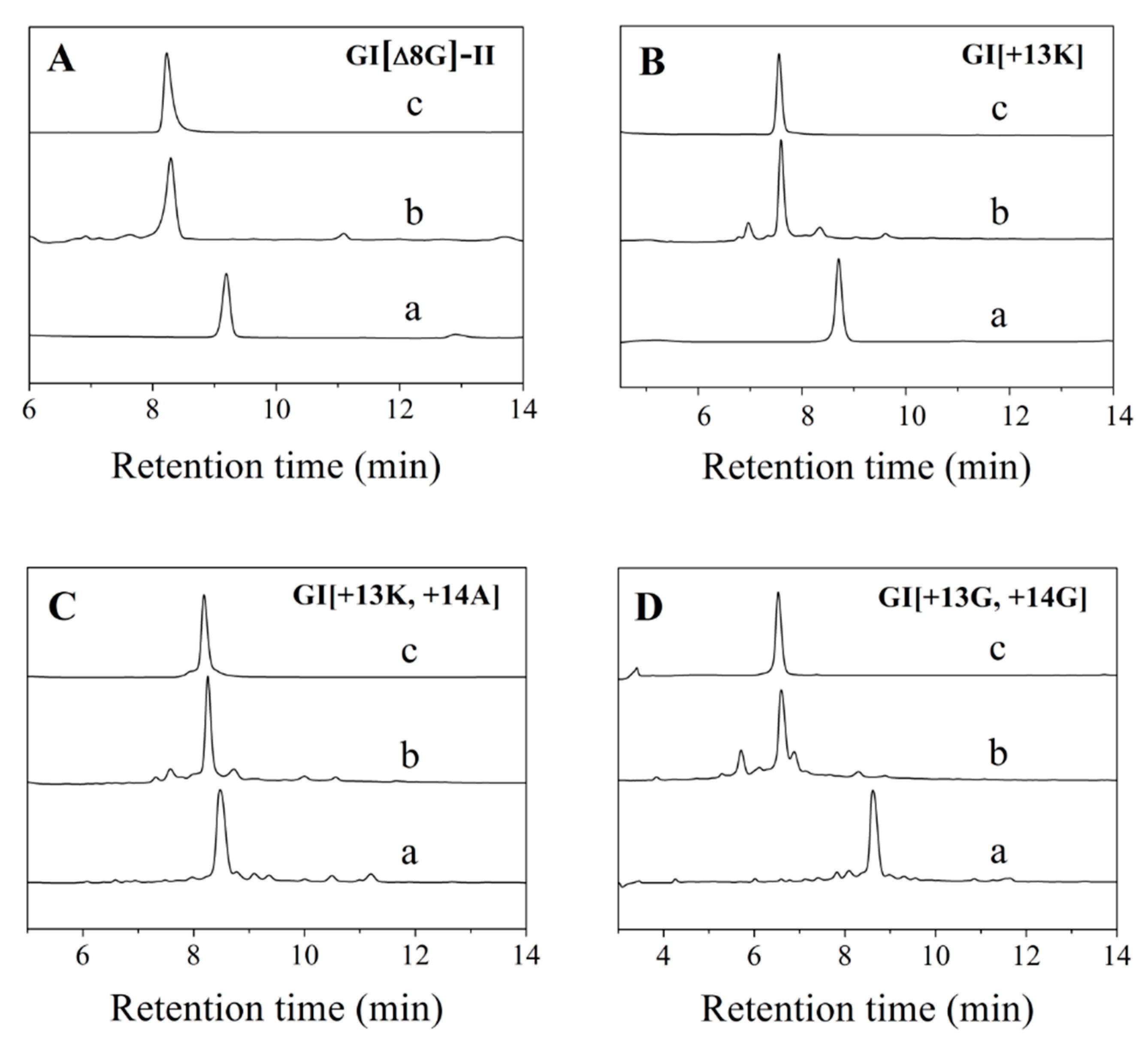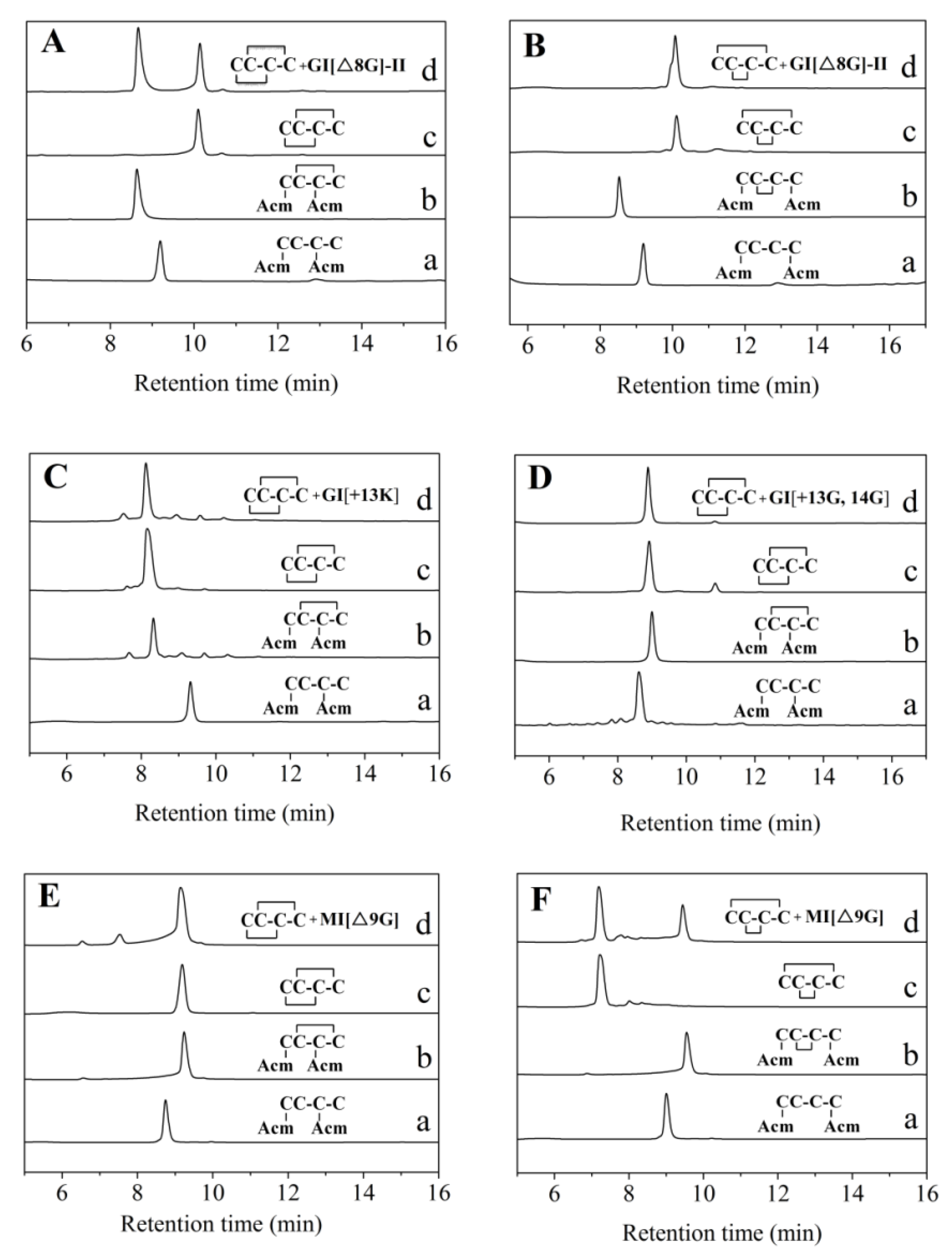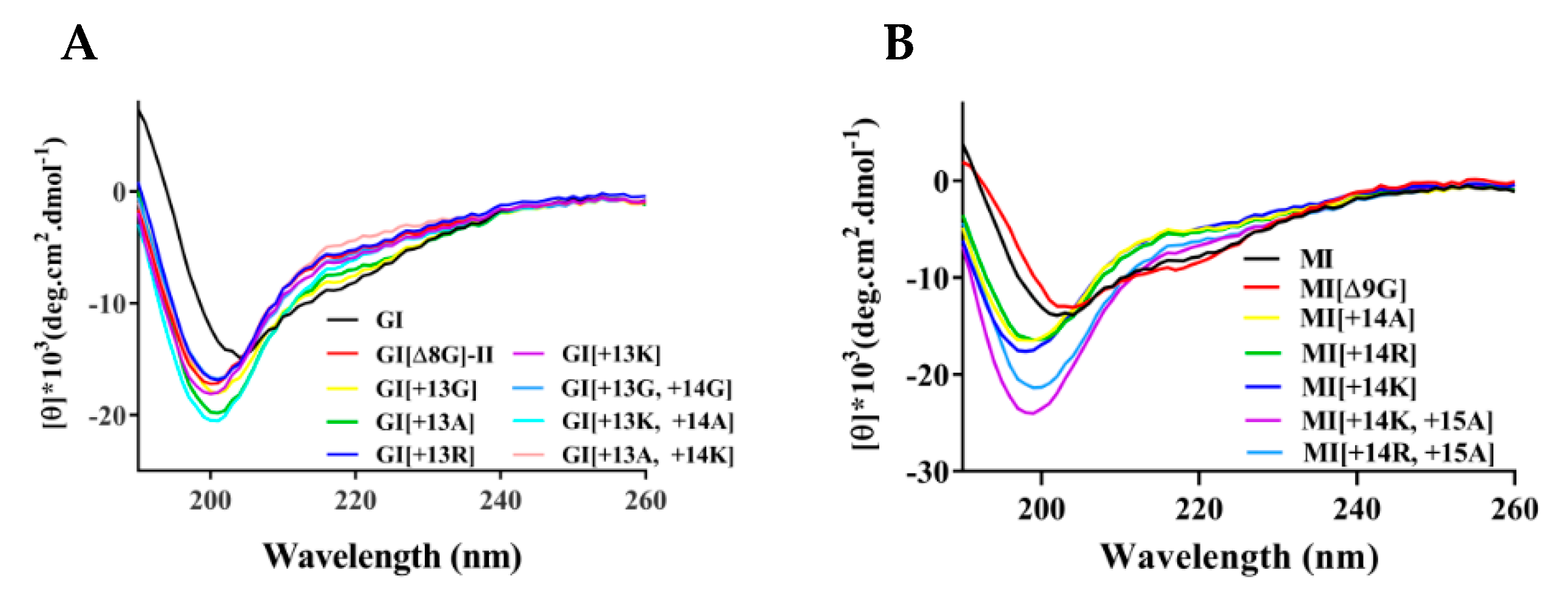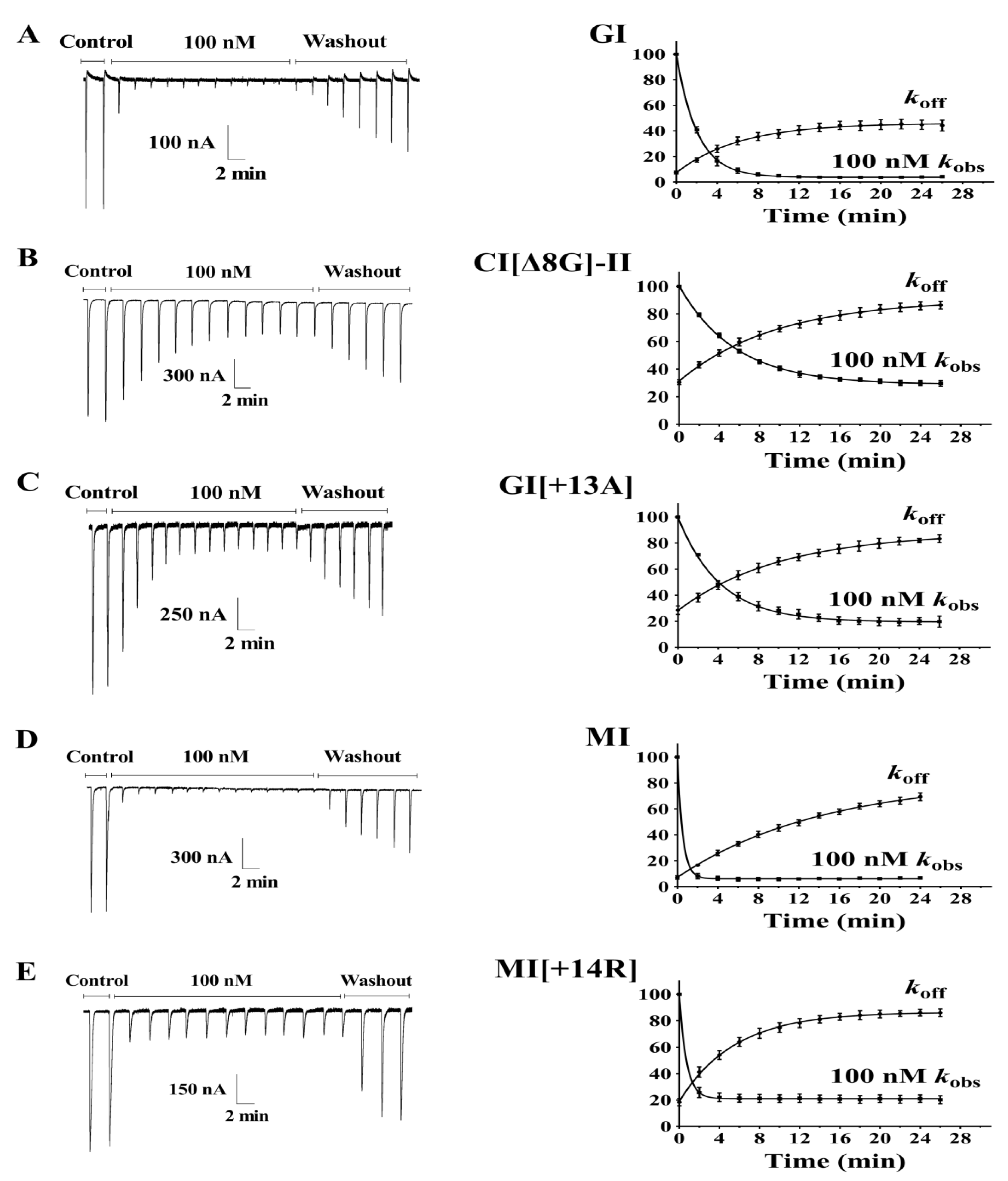The 3/4- and 3/6-Subfamily Variants of α-Conotoxins GI and MI Exhibit Potent Inhibitory Activity against Muscular Nicotinic Acetylcholine Receptors
Abstract
:1. Introduction
2. Results
2.1. Synthesis and Characterization of Conotoxins
2.2. Disulfide Bond Connectivity
2.3. Circular Dichroism (CD) Spectroscopy
2.4. Inhibitory Activity of α-Conotoxins GI and MI Variants against Muscular nAChRs
2.5. On-Rate and Off-Rate Kinetics for α-Conotoxins GI and MI Variants Interacting with Muscular nAChRs
2.6. Toxicity of GI and MI Variants in Mice
3. Discussion
4. Materials and Methods
4.1. Materials, Reagents, and Animals
4.2. Peptide Synthesis and Folding
4.3. Determination of Disulfide Bond Connectivity
4.4. Circular Dichroism (CD) Spectra
4.5. Oocyte Two-Electrode Voltage Clamp
4.6. Toxicity Tests
Author Contributions
Funding
Institutional Review Board Statement
Informed Consent Statement
Conflicts of Interest
References
- Albuquerque, E.X.; Pereira, E.F.; Alkondon, M.; Rogers, S.W. Mammalian nicotinic acetylcholine receptors: From structure to function. Physiol. Rev. 2009, 89, 73–120. [Google Scholar] [CrossRef] [Green Version]
- Zoli, M.; Pucci, S.; Vilella, A.; Gotti, C. Neuronal and extraneuronal nicotinic acetylcholine receptors. Curr. Neuropharmacol. 2018, 16, 338–349. [Google Scholar] [CrossRef]
- Wonnacott, S.; Bermudez, I.; Millar, N.S.; Tzartos, S.J. Nicotinic acetylcholine receptors. Br. J. Pharmacol. 2018, 175, 1785–1788. [Google Scholar] [CrossRef] [Green Version]
- Bertrand, D.; Terry, A.V., Jr. The wonderland of neuronal nicotinic acetylcholine receptors. Biochem. Pharmacol. 2018, 151, 214–225. [Google Scholar] [CrossRef] [PubMed]
- Cisterna, B.A.; Vargas, A.A.; Puebla, C.; Fernández, P.; Escamilla, R.; Lagos, C.F.; Matus, M.F.; Vilos, C.; Cea, L.A.; Barnafi, E.; et al. Active acetylcholine receptors prevent the atrophy of skeletal muscles and favor reinnervation. Nat. Commun. 2020, 11, 1073. [Google Scholar] [CrossRef] [Green Version]
- Becchetti, A.; Aracri, P.; Meneghini, S.; Brusco, S.; Amadeo, A. The role of nicotinic acetylcholine receptors in autosomal dominant nocturnal frontal lobe epilepsy. Front. Physiol. 2015, 6, 22. [Google Scholar] [CrossRef] [PubMed] [Green Version]
- Ved, H.S.; Doshi, G.M. A review on emerging drug targets in treatment of Schizophrenia. Curr. Drug Targets 2020, 21, 1593–1605. [Google Scholar] [CrossRef]
- Hone, A.J.; McIntosh, J.M. Nicotinic acetylcholine receptors in neuropathic and inflammatory pain. FEBS Lett. 2018, 592, 1045–1062. [Google Scholar] [CrossRef] [PubMed] [Green Version]
- Lebbe, E.K.; Peigneur, S.; Wijesekara, I.; Tytgat, J. Conotoxins targeting nicotinic acetylcholine receptors: An overview. Mar. Drugs 2014, 12, 2970–3004. [Google Scholar] [CrossRef] [PubMed] [Green Version]
- Jin, A.H.; Muttenthaler, M.; Dutertre, S.; Himaya, S.W.A.; Kaas, Q.; Craik, D.J.; Lewis, R.J.; Alewood, P.F. Conotoxins: Chemistry and biology. Chem. Rev. 2019, 119, 11510–11549. [Google Scholar] [CrossRef]
- Turner, M.W.; Marquart, L.A.; Phillips, P.D.; McDougal, O.M. Mutagenesis of α-conotoxins for enhancing activity and selectivity for nicotinic acetylcholine receptors. Toxins 2019, 11, 113. [Google Scholar] [CrossRef] [Green Version]
- Robinson, S.D.; Norton, R.S. Conotoxin gene superfamilies. Mar. Drugs 2014, 12, 6058–6101. [Google Scholar] [CrossRef] [Green Version]
- Wu, R.J.; Wang, L.; Xiang, H. The structural features of α-conotoxin specifically target different isoforms of nicotinic acetylcholine receptors. Curr. Top. Med. Chem. 2015, 16, 156–169. [Google Scholar] [CrossRef] [PubMed]
- Kennedy, A.C.; Belgi, A.; Husselbee, B.W.; Spanswick, D.; Norton, R.S.; Robinson, A.J. α-Conotoxin peptidomimetics: Probing the minimal binding motif for effective analgesia. Toxins 2020, 12, 505. [Google Scholar] [CrossRef]
- Li, X.; Tae, H.S.; Chu, Y.; Jiang, T.; Adams, D.J.; Yu, R. Medicinal chemistry, pharmacology, and therapeutic potential of α-conotoxins antagonizing the α9α10 nicotinic acetylcholine receptor. Pharmacol. Ther. 2021, 222, 107792. [Google Scholar] [CrossRef] [PubMed]
- Gray, W.R.; Luque, F.A.; Galyean, R.; Atherton, E.; Sheppard, R.C.; Stone, B.L.; Reyes, A.; Alford, J.; McIntosh, M.; Olivera, B.M.; et al. Conotoxin GI: Disulfide bridges, synthesis, and preparation of iodinated derivatives. Biochemistry 1984, 23, 2796–2802. [Google Scholar] [CrossRef] [PubMed]
- Hann, R.M.; Pagán, O.R.; Gregory, L.M.; Jácome, T.; Eterović, V.A. The 9-arginine residue of alpha-conotoxin GI is responsible for its selective high affinity for the alphagamma agonist site on the electric organ acetylcholine receptor. Biochemistry 1997, 36, 9051–9056. [Google Scholar] [CrossRef] [PubMed]
- Ning, J.; Li, R.; Ren, J.; Zhangsun, D.; Zhu, X.; Wu, Y.; Luo, S. Alanine-scanning mutagenesis of α-conotoxin GI reveals the residues crucial for activity at the muscle acetylcholine receptor. Mar. Drugs 2018, 16, 507. [Google Scholar] [CrossRef] [PubMed] [Green Version]
- Tae, H.S.; Gao, B.; Jin, A.H.; Alewood, P.F.; Adams, D.J. Globular and ribbon isomers of Conus geographus α-conotoxins antagonize human nicotinic acetylcholine receptors. Biochem. Pharmacol. 2021, 190, 114638. [Google Scholar] [CrossRef]
- Gray, W.R.; Rivier, J.E.; Galyean, R.; Cruz, L.J.; Olivera, B.M. Conotoxin MI. disulfide bonding and conformational states. J. Biol. Chem. 1983, 258, 12247–12251. [Google Scholar] [CrossRef]
- Papineni, R.V.; Sanchez, J.U.; Baksi, K.; Willcockson, I.U.; Pedersen, S.E. Site-specific charge interactions of alpha-conotoxin MI with the nicotinic acetylcholine receptor. J. Biol. Chem. 2001, 276, 23589–23598. [Google Scholar] [CrossRef] [Green Version]
- Gray, W.R.; Luque, A.; Olivera, B.M.; Barrett, J.; Cruz, L.J. Peptide toxins from Conus geographus venom. J. Biol. Chem. 1981, 256, 4734–4740. [Google Scholar] [CrossRef]
- Myers, R.A.; Zafaralla, G.C.; Gray, W.R.; Abbott, J.; Cruz, L.J.; Olivera, B.M. Alpha-conotoxins, small peptide probes of nicotinic acetylcholine receptors. Biochemistry 1991, 30, 9370–9377. [Google Scholar] [CrossRef] [PubMed]
- Groebe, D.R.; Gray, W.R.; Abramson, S.N. Determinants involved in the affinity of alpha-conotoxins GI and SI for the muscle subtype of nicotinic acetylcholine receptors. Biochemistry 1997, 36, 6469–6474. [Google Scholar] [CrossRef]
- Benie, A.J.; Whitford, D.; Hargittai, B.; Barany, G.; Janes, R.W. Solution structure of alpha-conotoxin SI. FEBS Lett. 2000, 476, 287–295. [Google Scholar] [CrossRef] [Green Version]
- Favreau, P.; Krimm, I.; Le-Gall, F.; Bobenrieth, M.J.; Lamthanh, H.; Bouet, F.; Servent, D.; Molgo, J.; Ménez, A.; Letourneux, Y.; et al. Biochemical characterization and nuclear magnetic resonance structure of novel alpha-conotoxins isolated from the venom of Conus consors. Biochemistry 1999, 38, 6317–6326. [Google Scholar] [CrossRef]
- Giribaldi, J.; Wilson, D.; Nicke, A.; El-Hamdaoui, Y.; Laconde, G.; Faucherre, A.; Moha-Ou-Maati, H.; Daly, N.L.; Enjalbal, C.; Dutertre, S. Synthesis, structure and biological activity of CIA and CIB, two α-conotoxins from the predation-evoked venom of Conus catus. Toxins 2018, 10, 222. [Google Scholar] [CrossRef] [Green Version]
- Peigneur, S.; Devi, P.; Seldeslachts, A.; Ravichandran, S.; Quinton, L.; Tytgat, J. Structure-function elucidation of a new α-conotoxin, MilIA, from Conus milneedwardsi. Mar. Drugs 2019, 17, 535. [Google Scholar] [CrossRef] [Green Version]
- Martinez, J.S.; Olivera, B.M.; Gray, W.R.; Craig, A.G.; Groebe, D.R.; Abramson, S.N.; McIntosh, J.M. Alpha-conotoxin EI, a new nicotinic acetylcholine receptor antagonist with novel selectivity. Biochemistry 1995, 34, 14519–14526. [Google Scholar] [CrossRef]
- Han, K.H.; Hwang, K.J.; Kim, S.M.; Kim, S.K.; Gray, W.R.; Olivera, B.M.; Rivier, J.; Shon, K.J. NMR structure determination of a novel conotoxin, [Pro 7,13] alpha-conotoxin PIVA. Biochemistry 1997, 36, 1669–1677. [Google Scholar] [CrossRef] [PubMed]
- Teichert, R.W.; Rivier, J.; Dykert, J.; Cervini, L.; Gulyas, J.; Bulaj, G.; Ellison, M.; Olivera, B.M. Alpha-conotoxin OIVA defines a new alpha-conotoxin subfamily of nicotinic acetylcholine receptor inhibitors. Toxicon 2004, 44, 207–214. [Google Scholar] [CrossRef] [PubMed]
- Teichert, R.W.; Rivier, J.; Torres, J.; Dykert, J.; Miller, C.; Olivera, B.M. A uniquely selective inhibitor of the mammalian fetal neuromuscular nicotinic acetylcholine receptor. J. Neurosci. 2005, 25, 732–736. [Google Scholar] [CrossRef]
- López-Vera, E.; Jacobsen, R.B.; Ellison, M.; Olivera, B.M.; Teichert, R.W. A novel alpha conotoxin (alpha-PIB) isolated from C. purpurascens is selective for skeletal muscle nicotinic acetylcholine receptors. Toxicon 2007, 49, 1193–1199. [Google Scholar] [CrossRef]
- Chi, S.W.; Park, K.H.; Suk, J.E.; Olivera, B.M.; McIntosh, J.M.; Han, K.H. Solution conformation of alpha-conotoxin EIVA, a potent neuromuscular nicotinic acetylcholine receptor antagonist from Conus ermineus. J. Biol. Chem. 2003, 278, 42208–42213. [Google Scholar] [CrossRef] [Green Version]
- Quinton, L.; Servent, D.; Girard, E.; Molgó, J.; Le-Caer, J.P.; Malosse, C.; Haidarel, A.; Lecoq, A.; Gilles, N.; Chamot-Rooke, J. Identification and functional characterization of a novel α-conotoxin (EIIA) from Conus ermineus. Anal. Bioanal. Chem. 2013, 405, 5341–5351. [Google Scholar] [CrossRef] [PubMed]
- Hoggard, M.F.; Rodriguez, A.M.; Cano, H.; Clark, E.; Tae, H.S.; Adams, D.J.; Godenschwege, T.A.; Marí, F. In vivo and in vitro testing of native α-conotoxins from the injected venom of Conus purpurascens. Neuropharmacology 2017, 127, 253–259. [Google Scholar] [CrossRef] [Green Version]
- Rybin, M.J.; O’Brien, H.; Ramiro, I.B.L.; Azam, L.; McIntosh, J.M.; Olivera, B.M.; Safavi-Hemami, H.; Yoshikami, D. αM-conotoxin MIIIJ blocks nicotinic acetylcholine receptors at neuromuscular junctions of frog and fish. Toxins 2020, 12, 197. [Google Scholar] [CrossRef] [PubMed] [Green Version]
- Maslennikov, I.V.; Sobol, A.G.; Gladky, K.V.; Lugovskoy, A.A.; Ostrovsky, A.G.; Tsetlin, V.I.; Ivanov, V.T.; Arseniev, A.S. Two distinct structures of alpha-conotoxin GI in aqueous solution. Eur. J. Biochem. 1998, 254, 238–247. [Google Scholar] [CrossRef]
- Faragó, Z.; Mirzahosseini, A.; Horváth, D.; Pálla, T.; Horváth, P.; Perczel, A.; Noszál, B. Solution structure and acid-base properties of reduced α-conotoxin MI. Chem. Biodivers. 2021, e2100464. [Google Scholar] [CrossRef]
- He, Y.; Cheng, J.; Lu, H.; Li, J.; Hu, J.; Qi, Z.; Liu, Z.; Jiang, S.; Dai, Q. Potent HIV fusion inhibitors against Enfuvirtide-resistant HIV-1 strains. Proc. Natl. Acad. Sci. USA 2008, 105, 16332–16337. [Google Scholar] [CrossRef] [Green Version]
- Wang, S.; Zhao, C.; Liu, Z.; Wang, X.; Liu, N.; Du, W.; Dai, Q. Structural and functional characterization of a novel α-conotoxin Mr1.7 from Conus marmoreus targeting neuronal nAChR α3β2, α9α10 and α6/α3β2β3 subtypes. Mar. Drugs 2015, 13, 3259–3275. [Google Scholar] [CrossRef] [PubMed] [Green Version]
- Chen, J.; Liang, L.; Ning, H.; Cai, F.; Liu, Z.; Zhang, L.; Zhou, L.; Dai, Q. Cloning, synthesis and functional characterization of a novel α-conotoxin Lt1.3. Mar. Drugs 2018, 16, 112. [Google Scholar] [CrossRef] [PubMed] [Green Version]
- Labarca, C.; Nowak, M.W.; Zhang, H.; Tang, L.; Deshpande, P.; Lester, H.A. Channel gating governed symmetrically by conserved leucine residues in the M2 domain of nicotinic receptors. Nature 1995, 376, 514–516. [Google Scholar] [CrossRef] [PubMed]
- Cai, F.; Xu, N.; Liu, Z.; Ding, R.; Yu, S.; Dong, M.; Wang, S.; Shen, J.; Tae, H.S.; Adams, D.J.; et al. Targeting of N-type calcium channels via GABAB-receptor activation by α-conotoxin Vc1.1 variants displaying improved analgesic activity. J. Med. Chem. 2018, 61, 10198–10205. [Google Scholar] [CrossRef] [PubMed]





| NO. | Name | Amino Acid Sequences | Theoretical MW (Experimental) (Da) | IC50 (nM) (95%) Confidence Intervals |
|---|---|---|---|---|
| GI | ECCNPACGRHYSC * | 1436.52 (1437.49) | 42.0 (38.8–45.4) | |
| 1 | GI[∆8G]-I a | ECCNPACRHYSC * | 1379.49 (1380.46) | 248.1 (221.3–275.9) |
| 2 | GI[∆8G]-II b | ECCNPACRHYSC * | 1379.49 (1380.41) | 50.4 (45.9–55.4) |
| 3 | GI[+13G] | ECCNPACGRHYSGC * | 1493.54 (1493.51) | >200 |
| 4 | GI[+13A] | ECCNPACGRHYSAC * | 1507.55 (1508.47) | 45.4 (41.7–49.3) |
| 5 | GI[+13R] | ECCNPACGRHYSRC * | 1592.62(1593.51) | 73.5 (69.2–78.1) |
| 6 | GI[+13K] | ECCNPACGRHYSKC * | 1564.61 (1565.50) | 47.7 (44.2–51.5) |
| 7 | GI[+13G, +14G] | ECCNPACGRHYSGGC * | 1550.56 (1551.48) | >200 |
| 8 | GI[+13K, +14A] | ECCNPACGRHYSKAC * | 1635.65 (1636.54) | >500 |
| 9 | GI[+13A, +14K] | ECCNPACGRHYSAKC * | 1635.65 (1636.54) | >500 |
| MI | GRCCHPACGKNYSC * | 1492.59 (1439.38) | 7.0 (5.6–8.8) | |
| 10 | MI[∆9G] | GRCCHPACKNYSC * | 1435.57 (1436.46) | >500 |
| 11 | MI[+14A] | GRCCHPACGKNYSAC * | 1563.63 (1564.52) | >200 |
| 12 | MI[+14R] | GRCCHPACGKNYSRC * | 1648.69 (1649.58) | 22.2 (19.8–25.1) |
| 13 | MI[+14K] | GRCCHPACGKNYSKC * | 1620.68 (1621.58) | 62.7 (57.9–67.9) |
| 14 | MI[+14K, +15A] | GRCCHPACGKNYSKAC * | 1691.72 (1692.61) | >500 |
| 15 | MI[+14R, +15A] | GRCCHPACGKNYSRAC * | 1719.73 (1720.62) | >500 |
| α-CTX | koff | t1/2a | kobsb | kon | Kic |
|---|---|---|---|---|---|
| min−1 | min | min−1 | min−1 M−1 | M−9 | |
| GI | 0.16 ± 0.03 | 4.26 (3.16–6.54) | 0.49 ± 0.02 | 0.33 × 107 | 48.48 |
| GI[∆8G]-II | 0.10 ± 0.01 | 6.63 (5.25–8.99) | 0.18 ± 0.01 | 0.08 × 107 | 125.0 |
| GI[+13A] | 0.10 ± 0.02 | 7.04 (5.26–10.65) | 0.23 ± 0.02 | 0.13 × 107 | 76.92 |
| MI | 0.07 ± 0.01 | 9.82 (7.67–13.67) | 1.92 ± 0.31 | 1.85 ×107 | 3.78 |
| MI[+14R] | 0.18 ± 0.02 | 3.78 (3.12–4.80) | 1.40 ± 0.31 | 1.22 ×107 | 14.75 |
| α-Conotoxins GI and MI Variant | 20 µg/kg | 40 µg/kg | 80 µg/kg | 120 µg/kg | 160 µg/kg | 200 µg/kg | ||||||
|---|---|---|---|---|---|---|---|---|---|---|---|---|
| Death Time (s) | Death Rate (%) | Death Time (s) | Death Rate (%) | Death Time (s) | Death Rate (%) | Death Time (s) | Death Rate (%) | Death Time (s) | Death Rate (%) | Death Time (s) | Death Rate (%) | |
| GI | 0 | 1075.3 ± 150.5 | 100 | |||||||||
| GI[Δ8G]-II | 0 | 0 | 1462.8 ± 851.9 | 60 | 886.6 ± 392.0 | 80 | ||||||
| GI[+13G] | 1036.6 ± 215.6 | 30 | 610.5 ± 239.6 | 90 | ||||||||
| GI[+13A] | 0 | 0 | 1356.1 ± 41.1 | 20 | ||||||||
| GI[+13R] | 0 | 0 | 1441.5 ± 231.0 | 80 | 929.2 ± 297.3 | 90 | 704.5 ± 57.6 | 100 | ||||
| GI[+13K] | 1619 | 10 | 1199.9 ± 383.4 | 90 | 771.3 ± 96.8 | 100 | ||||||
| GI[+13G, +14G] | 0 | 0 | ||||||||||
| GI[+13K, +14A] | 0 | 0 | ||||||||||
| GI[+13A, +14K] | 0 | 0 | 0 | 0 | 1107.2 ± 250.3 | 100 | ||||||
| MI | 1185.7 ± 167.5 | 100 | ||||||||||
| MI[Δ9G] | 0 | 0 | ||||||||||
| MI[+14A] | 0 | 0 | ||||||||||
| MI[+14R] | 0 | 0 | ||||||||||
| MI[+14K] | 0 | 0 | 895.5 ± 383.9 | 20 | ||||||||
| MI[+14K, +15A] | 0 | 0 | ||||||||||
| MI[+14R, +15A] | 0 | 0 | ||||||||||
Publisher’s Note: MDPI stays neutral with regard to jurisdictional claims in published maps and institutional affiliations. |
© 2021 by the authors. Licensee MDPI, Basel, Switzerland. This article is an open access article distributed under the terms and conditions of the Creative Commons Attribution (CC BY) license (https://creativecommons.org/licenses/by/4.0/).
Share and Cite
Ma, X.; Huang, Q.; Yu, S.; Xu, S.; Huang, Y.; Zhao, Z.; Xiao, X.; Dai, Q. The 3/4- and 3/6-Subfamily Variants of α-Conotoxins GI and MI Exhibit Potent Inhibitory Activity against Muscular Nicotinic Acetylcholine Receptors. Mar. Drugs 2021, 19, 705. https://doi.org/10.3390/md19120705
Ma X, Huang Q, Yu S, Xu S, Huang Y, Zhao Z, Xiao X, Dai Q. The 3/4- and 3/6-Subfamily Variants of α-Conotoxins GI and MI Exhibit Potent Inhibitory Activity against Muscular Nicotinic Acetylcholine Receptors. Marine Drugs. 2021; 19(12):705. https://doi.org/10.3390/md19120705
Chicago/Turabian StyleMa, Xiaoli, Qiuyuan Huang, Shuo Yu, Shujing Xu, Yue Huang, Zhiming Zhao, Xinrong Xiao, and Qiuyun Dai. 2021. "The 3/4- and 3/6-Subfamily Variants of α-Conotoxins GI and MI Exhibit Potent Inhibitory Activity against Muscular Nicotinic Acetylcholine Receptors" Marine Drugs 19, no. 12: 705. https://doi.org/10.3390/md19120705
APA StyleMa, X., Huang, Q., Yu, S., Xu, S., Huang, Y., Zhao, Z., Xiao, X., & Dai, Q. (2021). The 3/4- and 3/6-Subfamily Variants of α-Conotoxins GI and MI Exhibit Potent Inhibitory Activity against Muscular Nicotinic Acetylcholine Receptors. Marine Drugs, 19(12), 705. https://doi.org/10.3390/md19120705





